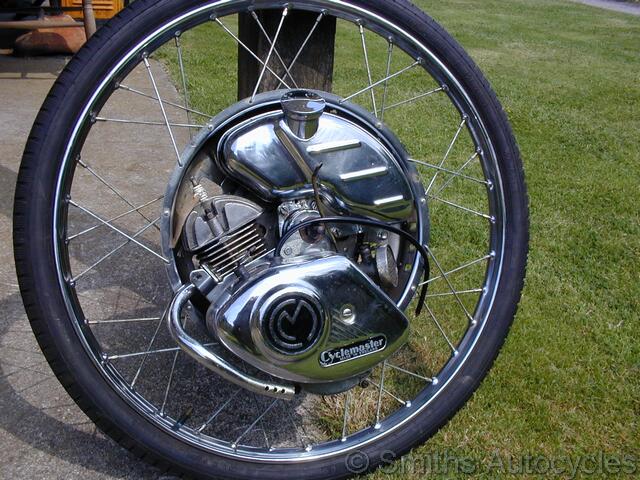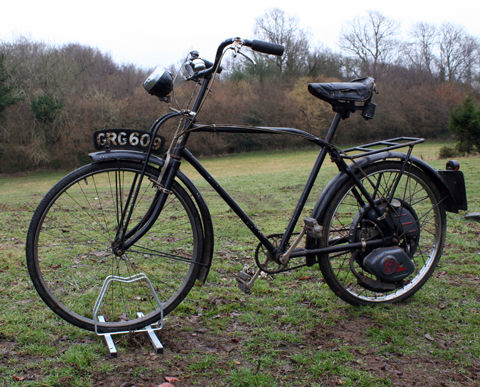From 1951
- Thread starter Jonah
- Start date
The 25cc black version back wheel is shown below, I used to fit them in the 1950s. Later models were 32cc in grey as in the second photo. There were many other makes with other drive methods:Advert extolling the virtues of fitting a motor assist kit. In St Andrews Museum.


D
Deleted member 4366
Guest
they didn't worry about that massive construction and use rules book then, did they? the only change to the bike is the motor-wheel and number plates.
My dad had one for a while. I can remember him pedalling all he was worth to get it started. I wish he were still around to tell me about it.
The nearest I had to one was the Honda PC50. I bought it used in 1977, and it did about 10 miles before all the spokes came loose and I was unable to fix it. It couldn't get up a medium hill on its own. I had to pedal it to keep the speed up.

My dad had one for a while. I can remember him pedalling all he was worth to get it started. I wish he were still around to tell me about it.
The nearest I had to one was the Honda PC50. I bought it used in 1977, and it did about 10 miles before all the spokes came loose and I was unable to fix it. It couldn't get up a medium hill on its own. I had to pedal it to keep the speed up.

Yes, the 50ccs of yesteryear were nothing like today's 50cc.The nearest I had to one was the Honda PC50. I bought it used in 1977, and it did about 10 miles before all the spokes came loose and I was unable to fix it. It couldn't get up a medium hill on its own. I had to pedal it to keep the speed up.
Even the two strongest of the 49cc bike motors in the 1950s, the PowerPak and the BSA Winged Wheel, couldn't begin to match today's typical e-bike climb ability.
.
Hang on my then girlfriend, and now current wife, had inherited a Honda 50 cub, from her big brother and was able to travel with me on the back up over the Dublin mountains in 76Yes, the 50ccs of yesteryear were nothing like today's 50cc.
Even the two strongest of the 49cc bike motors in the 1950s, the PowerPak and the BSA Winged Wheel, couldn't begin to match today's typical e-bike climb ability.
.
That was over 26 years after those I posted about, which were designed at the end of the 1940s and very poor climbers. They would have had no hope without their pedals. You may not be aware of it, but even the 98cc autocycles had to have pedals then, both to start and assist on steeper climbs.Hang on my then girlfriend, and now current wife, had inherited a Honda 50 cub, from her big brother and was able to travel with me on the back up over the Dublin mountains in 76
By the 1970s the small two strokes were much improved, mainly due to Italian and Japanese designers.
.
The other day I was passed in the car by a modern kitted 49cc scooter and I was doing 70 km/h. Very intelligent person had done the tuning because the original muffler had been retained so it wasn't spewing more dB than HP...
Moto GP racing used to have a 50cc class which could exceed 85mph (140 kph), later in the 1980s replaced by the 80cc class which was very popular in Spain.The other day I was passed in the car by a modern kitted 49cc scooter and I was doing 70 km/h.
And Moto 3 125ccs were impressive, the record top speed on an Aprilia being just over 155 mph (250 kph) back in 1996.
.
Last edited:
May I present to you my first mode of motorised transport!
The 50cc NSU Quickly!

The most agricultural piece of machinery you`ll ever find but seriously reliable. I seized it regulary, you just waited a few minutes till it cooled down and off you`d go again.
It was rare to have the proper petrol/oil mix in the tank, various substances were experimented with including furniture polish and Castrol R
Previous owner had taken the head off, drilled four holes in it, tapped threads and inserted bolts... why? Dunno, maybe raised compression?
The silencer was removed and replaced with a length of copper pipe.
The 50cc NSU Quickly!

The most agricultural piece of machinery you`ll ever find but seriously reliable. I seized it regulary, you just waited a few minutes till it cooled down and off you`d go again.
It was rare to have the proper petrol/oil mix in the tank, various substances were experimented with including furniture polish and Castrol R
Previous owner had taken the head off, drilled four holes in it, tapped threads and inserted bolts... why? Dunno, maybe raised compression?
The silencer was removed and replaced with a length of copper pipe.
Yes but that honda cub 50 was by then very second hand and probably was purchased new in 1962., As Japan was outgrowing the reputation for cheap tat. Her brother would have bought it second hand in about 1969.That was over 26 years after those I posted about, which were designed at the end of the 1940s and very poor climbers. They would have had no hope without their pedals. You may not be aware of it, but even the 98cc autocycles had to have pedals then, both to start and assist on steeper climbs.
By the 1970s the small two strokes were much improved, mainly due to Italian and Japanese designers.
.
Italian ?That was over 26 years after those I posted about, which were designed at the end of the 1940s and very poor climbers. They would have had no hope without their pedals. You may not be aware of it, but even the 98cc autocycles had to have pedals then, both to start and assist on steeper climbs.
By the 1970s the small two strokes were much improved, mainly due to Italian and Japanese designers.
.
They were good, vastly better performers than the same size 1950s cyclemotors. It was no accident that the latter didn't last long, by 1955 only three of the many companies once making them were still in the market with one announcing the end of production that October. The centre of interest by then were the 125cc Vespa and Lambretta scooters, which made far more sense since even assisted bicycles needed a full motorcycle licence.Yes but that honda cub 50 was by then very second hand and probably was purchased new in 1962.,
.
We didn't see them here, other than photos, but several of the Italian companies hadn't stood still on motorcycle design. Most of the publicity here was for the Gilera and later MV Agusta four cylinder race bikes, but the Italian home market was all about small two strokes from the likes of Benelli, Cagiva, Ducati, Moto Morini et al. Similarly the Spanish market and race scene. In both countries the 50cc and later 80cc Moto GP classes were very popular and they made big design strides.Italian ?
.
I think something nearly went seriously wrong there - I was trying to reply to Tommie to say that an NSU Quickly was my Dad's method of transport for some years and I was in awe of it as a 9 year old.May I present to you my first mode of motorised transport!
The 50cc NSU Quickly!
View attachment 21244
The most agricultural piece of machinery you`ll ever find but seriously reliable. I seized it regulary, you just waited a few minutes till it cooled down and off you`d go again.
It was rare to have the proper petrol/oil mix in the tank, various substances were experimented with including furniture polish and Castrol R
Previous owner had taken the head off, drilled four holes in it, tapped threads and inserted bolts... why? Dunno, maybe raised compression?
The silencer was removed and replaced with a length of copper pipe.
I doubt it could survive road use for long, one pothole or drain cover could make that rim eccentric and unusable.Has this ever surfaced anywhere in mass production?
.
D
Deleted member 4366
Guest
I did a lap of the Isle of Man TT circuit on a Honda Dax 50cc. we were down to 12 mph up the mountain from Ramsey, but at least I got a thumbs up from John McGuiness when I scraped everything going round a bend in front of him.
Related Articles
-
 MTF Enterprises announces acquisition of EMU Electric Bikes
MTF Enterprises announces acquisition of EMU Electric Bikes- Started by: Pedelecs
-
 Wisper 806T folding bike wins Which? ‘Best Buy’
Wisper 806T folding bike wins Which? ‘Best Buy’- Started by: Pedelecs
-
 Sustrans calls for protected cycle lanes
Sustrans calls for protected cycle lanes- Started by: Pedelecs
-
 Amazon launch their first UK e-cargo micromobility hub
Amazon launch their first UK e-cargo micromobility hub- Started by: Pedelecs







